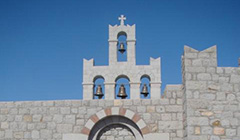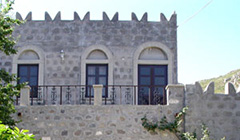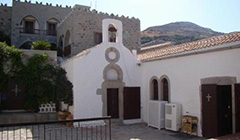
Monasteries
Patmos is tightly connected with its religious character and Christianity. Book of Revelation and the monastery of St.John the Evangelist, established in 1088 and never stopped working, have made the Island a worldwide significant religious centre. Beside the male monastery of Patmos you can visit the convent of the Annunciation and also the monastery of Zoodochos Pigi (in a free translation the monastery of the Life Giving Fountain) located at the centre of Chora.
Monastery of Zoodochos Pigi
It is in the middle exactly of the Skala to Chora path. It can be reached on foot
2,3Kms from the port of Skala or by Chora 2,2Kms.
The entrance is just on the road from Skala to Chora. If you choose to go there by
bus, you can use one of the very frequent schedule trips. Ask the bus driver to stop
at the middle of the route from Skala to Chora.
You can hike on the modern road or you can use the rocky one which is shorter and
more picturesque.
Patmos is the place where historically Apostle of Jesus John wrote the 270th and
last Book of the New Testament, Apocalypse, at 95 after Christ.
The energy aura, created centuries ago, is guiding all christians to the cave and it
is delivering the holy message to them. Despite that fact, there is a monk willing
to give you a tour around.
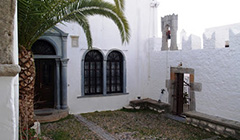
Saint John Theologos Monastery
Located at the southwest part of Chora, it can be easily reached on foot using the
road to Chora, crossing the square of Lossa where the statue of Emanouil Ksanthou
stands.
The square was used to be a local marketplace and nowadays is the Town
Hall too. Following down the road behind the Town Hall you will reach a small
marketplace on your left, at the crossroad after that choose the right wing and at
the three wooden signs on the wall you will find the monastery's direction.
The alley leads to a wider street and after 5 meters on the right lies the entrance.
A narrow passage between high white walls leads to the main entrance, a heavy wooden
gate reinforced with pieces of steel. Half of it remains open indicating the
visiting hours.
This monastery, established back in 1607, is only for women nuns and it is
located only 5 minutes far from the town center, where it stands still peacefully
and quietly away from tourists eyes.
The monastery is under reconstruction, but the visiting part of it worths the
effort to reach it!
Vocamvilies and lots of other flowers decorate in the most naturally way the yards
that the nuns silently take care all year round.
At the church of Saint John the Theologos, but also at the church of Zoodochos
Pigi, you will see paintings of the 16th to 18th century true mastepieces of the
orthodox religious art. Nuns work for charity purposes and produce things, among
them, weaves of religious significance.
The Library of the monastery is a unique cultural heritage. It contains more
than 3000 published books, 900 handwritten and more than 13000 manuscripts, some of
them written
back in 10th century.
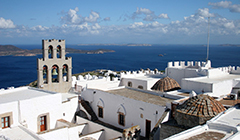

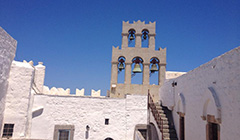
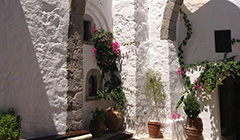
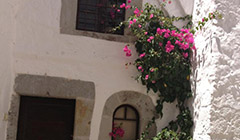


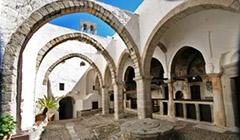
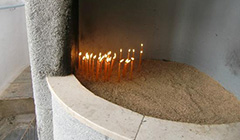
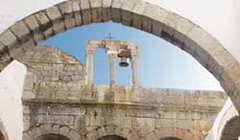

Revelation Cave and Monastery
Follow the rocky road leading higher that starts next to the kiosk near the bus
stop. Walk in front of the shops and after "Artemis" souvenirs you will find the
wide stairs that lead to the monastery.
You can reach Chora with frequent buses from Skala, Grikos and Kampos. At the
entrance of Chora there is a public parking place where you can park your vehicle,
because cars are not allowed within Chora. Keep in mind that there is not a parking
place inside Chora.
Hint: In the evening where the sun and light conditions are mild we suggest to take
a bus till Chora and on your way back you can pass by the Cave of Revelation, it's a
pleasant walk.
Monastery of Saint John the Evangelist or Theologos, the one who speaks for God, is
a magnificent Byzantine castle built at the top of Chora's Hill and it is the first
image impression of Patmos that you will have! Established at 1088 by Holy Father
Christodoulos to whom it was gifted together with the entire Island by the Emperror
of Byzantio Alexios Komninos.
The monastery stands high up to 15meters being 53 meters long and 70 meters wide!
The impression that gives you is even bigger if you look high standing at it's
Castle reinforced Gate.
You can still see the protection mechanism above the gate with the word "dolofonos"
which means assasin. There was an opening on the wall from where monks spilled hot
oil, water or even melted lead in order to keep away intruders pirates from ramming
the gate.
There was an alarm system with bells that monks used to inform villagers about an
upcoming attack. All villagers were going inside the castle monastery. That was the
reason to be designed like castle, in order to protect christians. The main entrance
into the buildings is at the north edge and there is a smaller one in the opposite
south wall, which nowadays remains unused. The monastery keeps expanding through the
ages in order to satisfy monks needs. The older parts of north and east wings have a
primature shape on the walls revealing the furious way the buildings were done in
order to protect the surrounding areas.
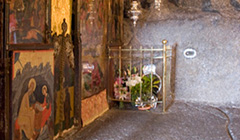

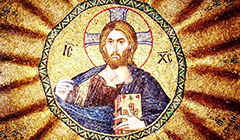
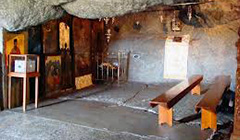
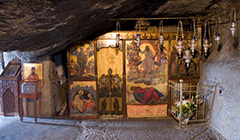
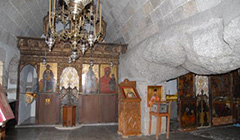
Monastery of the nuns of Evangelismos (the convent of the Annunciation)
Monastery of Evangelismos (the convent of the Annunciation) is located at the
southwest edge of Chora, in a distance of 15 mins on foot from the nearest bus
station.
It has a panoramic view over the gulf of Kipon (garden).
Initially the monastery was only a church until 1613, when the leader of monastery
of Saint John, Nikiforos, renewed the building and dedicated to Evangelist Loukas.
The Monastery hosts more than 40 nuns who are doing many things such as charities,
voluntary work for the local community, gardening, beekeeping, and the byzantine
style of embroidery with the unique technique of "spitha" which means sparkle.
